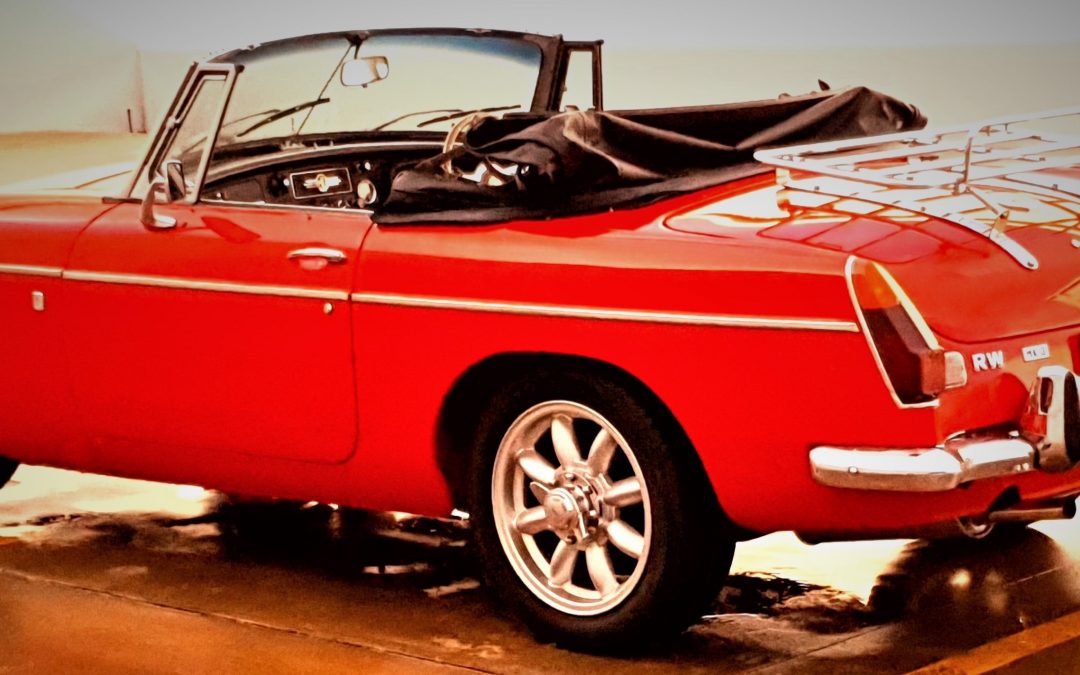
by Terry Maynard | Dec 9, 2020 | Review
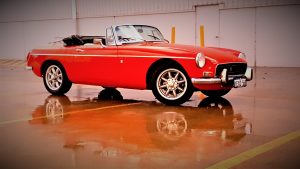
Related posts
I was casually looking at buying a convertible sports car again, something I’d done a lot off and on over the years. In my youth, I owned a Datsun 2000S Fairlady for 10 years, which in a moment many times regretted it got sold.
Search:
My search was starting to get a bit more serious. Mazda MX5’s were high on the list and really there isn’t much else in the market unless older classic cars are added to the search criteria which I wasn’t 100% sure I wanted to go down the path of fixing and working on old cars again. Rear-wheel drive, convertible and interior space to accommodate me, I’m 6′ tall, were must-haves, the performance was not overly important but would be a bonus.
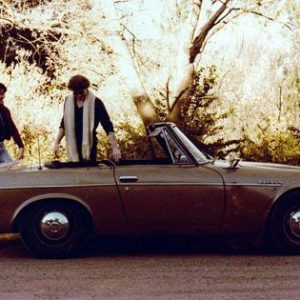
I made a few casual enquiries about the MX5. The Alfa Romeo 2000 Spider began to stand out as an option while reviews spoke of the Alfas as being more refined than their counterparts of the day like the MGB, with their twin-cam alloy engine, disk brakes all round, 5-speed gearbox etc.
Meanwhile a very tidy, fully and properly restored and somewhat modified MGB Roadster popped up for sale locally. I didn’t think I’d be that interested as I had a few years before looked at a couple and found them a bit rough and tight to get in and out of. With the idea of being a good comparison to the Alfa I was due to look at the next day I went to kick the tyres and take it for a spin. Wow, what an impression that car made on me. It looked fantastic, was comfortable and went like the clappers.
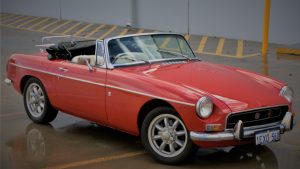
The time came around to check out the Alfa which at this stage I thought I’d be more interested in. The car apparently had a resto a long time ago but presented pretty rough. Sitting in it my knees felt like they were around my ears, driving it only got worse, it was agricultural, sluggish, the gears crunched and protested incessantly, I literally just went around the block, the fastest route back to end the experience was chosen, thanks but no thanks, good luck with your sale, se ya later.
The contrast was chalk and cheese, buying the MGB Roadster was a no brainer. Prices for both cars were about the same. Contact with the seller of the MGB was promptly made to arrange purchase. Now I’m the owner of this fantastic car that although its specification when new was less refined than the Alfa, the driving experience proved to be quite the opposite.
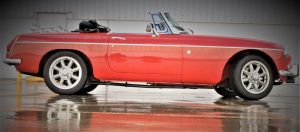
Cool Factor:
Beautifully prepared and presented it looks fantastic and is a very well sorted car to drive in every way, in fact, it rides better than my modern Hyundai. I’m always getting thumbs up from other motorists, shouts and whoops, and “nice car” at traffic lights and car parks. People readily approach me for a nostalgic chinwag. My son, who is reserved and introverted doesn’t get it, “How can you talk with someone like that when you don’t even know them’?
Cosmetics:
This car is more of an exception than the rule. It’s been properly restored and is a multiple trophy winner in MGCC of NSW Concours events in 1998 and 2000. It’s been cared for and maintained meticulously and only bought out for club and show events by its owner of 17 years who sold it in 2016.
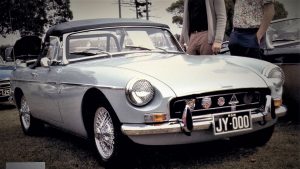
The duco presents beautifully in Pearl Red, of course, there’s no rust and the brightwork is immaculate. Pics prior to the restoration show the car in its original MG Bermuda Blue, a colour listed for the 1970 model year which suggests this car was made in 1970 but sold in 1971. The owner after 2016, Richard, my new best friend, made some mods. He replaced the immaculate spoke rims with Minator mini-light style 15-inch rims with centre lock wing nuts and low profile tyres, they look fantastic.
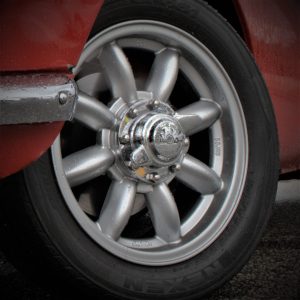
The interior is of course very nice. The last owner repaired the collapsed seat diaphragm and fitted new vinyl upholstery to the driver’s seat, all the carpets and vinyl are in great condition. I gotta say I love the old school MGB crackle finished dash, I’m a fan. Some of the electrics are a bit suspect, the interior lamp isn’t working, the fuel gauge is unreliable and the blinkers don’t work when the headlights are on, and the headlights are very dim as are the lights in the instruments, all of which need attention, pretty much the only thing to be faulted in the whole car.
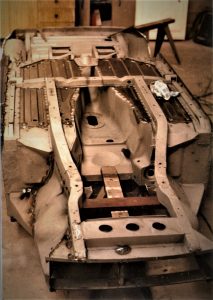
Driving:
Well, as I mentioned above, it drives and rides better than my modern Hyundai. In Spite of the 70’s style vibe, this is a very well sorted classic car, it drives, stops and handles like a dream. I must say thanks are due to the owner who restored and kept it in fantastic condition and also to Richard who owned it from 2016 to 2020 who sorted out a few bugs at considerable expense and sold me a beautifully presented and extremely well sorted classic car.
That aside, the driving experience is all MG joy. I don’t know if there are any more verbs, nouns or whatever to better describe it, it’s just a good experience. I had a 2001 model Alfa Romeo GTV V6 before this which is a fantastic driving experience but this MGB tops it hands down.
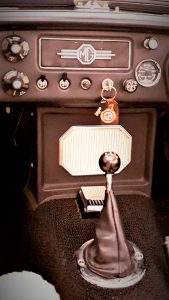
Interior Space:
For what essentially is a small car it’s very comfortable. It easily accommodates two adults, and what is very rare for me I actually bring the seat forward on its rails to reach the pedals. The 1st thing I do when sitting in any car is to put the seat back as far as it will go, the MGB is one of a handful of cars that I don’t need to do that.
I like the layout of the dashboard and I must say if the Japanese are masters at designing an intuitive dash layout, the English are masters of an aesthetically pleasing sports car layout.
The deck behind the seat has room for throwing loose items, bags, jumpers, stuff from a shopping expedition. The boot after the spare wheel and tools has limited space.
The steering wheel was replaced by the last owner, a 14″ Moto-Lita wood rim type and the look perfect on MGB’s and MGA’s. Being just that little bit smaller than the standard 15″ wheel makes getting in and out just a bit easier.
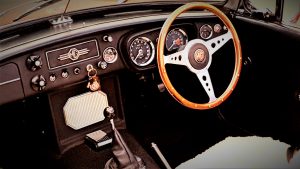
Performance:
Well, this is where things get interesting in this car. The last owner had the Moss Supercharger kit fitted along with extractors and a full stainless steel exhaust system of 1 3/4 inch pipe. Thanks, Richard, thumbs up my friend. The addition of a supercharger transforms these cars. Around town driving on the freeway is a very pleasurable experience, keeping abreast of the traffic is a breeze. Overdrive engaged at freeway speed the tacho hovers around the 2800 RPM mark, right in the sweet spot where this car just purrs and is ready to leap up the rev range with ease on demand, urging to gallop on. The exhaust note echoing off the concrete barriers hint at the willing performance. Four words drift into and reverberate through my mind, “This is #*^@# Superb”.
Exiting the freeway into the flow of suburban traffic and the pace changes but the driving experience doesn’t. Courtesy of the torque generated by the supercharger, the added grunt makes the lower speed negotiating of traffic lights, roundabouts and the like effortless. The car transforms from the ready and willing urge to ‘go’ on the freeway to a docile but at the same time comfortable but willing runabout. The same four words drift and reverberate through my mind, “this is #*^@# Superb”. I really can’t decide which experience is more rewarding, hurtling along the freeway, I’m loving it, pottering around the suburbs, I’m also loving it.
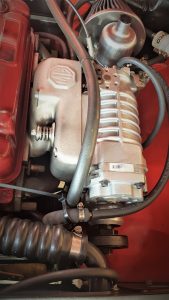
A dyno chart accompanied my purchase but I don’t know how to properly read it. I think HP peaks on a steep curve in 3rd gear at 4000 RPM to 108 HP, drops slightly in 4th then peaking again to 112HP at 5500 RPM in overdrive. Researching the system, Moss recommends a modest boost in a standard engine, which my car has, the aim is to strike a balance between performance and reliability. The dyno chart showed 90 HP before the supercharger was fitted.
On an MG, the supercharger in union with overdrive or dare I say a 5-speed gearbox is a combination made in heaven, this car is fitted with the original overdrive. In the MG scene fitting a supercharger is quite a popular performance upgrade though expensive. It beats shoehorning a V8 into one though I guess! The gearboxes in these cars are great to use, quite notchy and tight if they are in good condition with a fairly short throw. I have driven one in not so good condition and the box was loose and sloppy without that notchy feel. There is no spring loading in the H pattern gate which requires physically moving it through the gears otherwise there will be protests hitting the wrong gears, I learned very quickly.
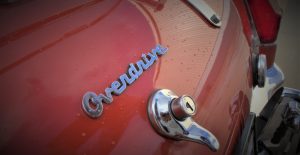
Handling:
The rack and pinion steering is precise, the driver feels all the bumps and dips in the road without it being too harsh, excellent. The original suspension on this car performs beautifully. Handling is superb and what stands out to me is the way it rides on the road, bumps are a gentle and smooth affair, the car has no shakes or rattles of any kind, it is just smooth and pleasant, not too harsh and not too soft. To me, it is the quintessential sports car ride.
Brakes:
The brakes too perform flawlessly. Added to the standard front discs and drum brake rear end is an aftermarket booster, courtesy again of the last owner, thanks, Richard. Looking back on the receipts a lot of time and money had been poured into the brakes for reasons unknown to me. There are receipts from the owner who restored it and from Richard that add up to a lot of money. Whatever the problem was it is not present now as the braking performance is fantastic.
Summary:
The engine performs beautifully in this car, what looks like the standard cooling system works properly which is a necessity with a supercharger fitted, oil leaks seem to be minimal. Underneath the car is immaculate, the gaiters and all the rubbers are in great condition, the steering is direct and sweet.
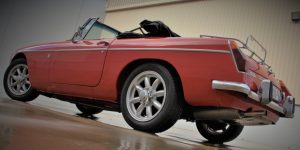
Richard claims to have had it at quite high speed, somewhere in the 120mph range and reports the car is stable and superb. I don’t think I’ll be testing it to confirm or bust his claims.
So that is a wrap on this lovely example of the 1971 MGB L Roadster. The driving experience of this car is such that it is an easy stretch of the imagination to think that you may be behind the wheel of a meticulously prepared and expensive exotic classic, all amplified when the top is down. In a word, “Superb”.
Happy trails all.

by Terry Maynard | Dec 8, 2020 | Review

It’s funny how things come about sometimes. Buying my nice MGB roadster initiated my brother and I looking into all things MG related. Watching the market we identified it was a good time to buy. This MGA popped up in my local market and we bit the bullet and invested in joint ownership of this very cool classic.
Driving… It’s a truck load of MG joy to drive these cars. It really is a joy cruising down the road, very enjoyable. A standard MGA is not a performance car, maybe in its day but not by todays standards. It is more a car that is a delight to drive at a leisurely pace when it is not too hot or not too cold, a fresh morning or evening, a nice mild day time temperature or balmy summers evening, it is terribly English and terribly civilised, simply a delight, an experience to savour like nice food or fine wine.
Interior Space… To get in I slide in under the 14″ after marker steering wheel. I’m 6′ tall. Once in and under the wheel all is good with reasonable legroom and comfort. The steering wheel is close to my chest, it’s comfortable enough though and it doesn’t take long to get used to the driving position. Exiting is a reverse of getting in, I kind of slide back out with gentle assistance from the bracket supporting the windscreen.

The cockpit is quite small with plenty of room for 2 adults but not much else. As there are no window winding mechanisms the space in the doors become stowage room, handy for phones, garage remotes, water bottles, hat, beanie and the like. What I think is really cool is to reach into this space to pull the wire cable that opens the doors.

Space in the footwell is reasonable but the peddles are very close together. Driving in small soft shoes is a must. It didn’t take too long though to work out how to negotiate it, there’s a knack to it that I learned very quickly which I do without thinking now.

Rear stowage… There’s a stowage bag suspended in the rear shelf, very handy and it is designed to stow away the detachable side screens and other small flat items. The one in this car is original factory equipment.
Boot… There’s not a great deal of boot space with the 15″ spare wheel, jack, tools and sundry items.
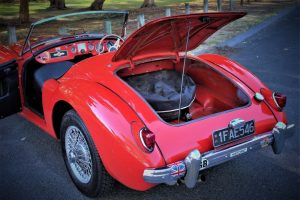
Performance… Well, I think for a car that sold new in 1957, with English engineering much more dated than that, the B series engine having its origins in 1947, it gets through modern traffic quite well. There’s enough get up and boogie in the 1500 twin SU equipped pushrod engine to negotiate traffic and freeway conditions. This car is equipped with an upgraded radiator that keeps it running cool for light general running about and club duties.

Braking… The factory drum brakes on 1500 model cars are a little on the agricultural side. The stopping power of modern cars in traffic and freeway conditions made me quite nervous and got my heart racing. Visions of the precious MGA rear ending a Hyundai or whatever is not a good scenario to be contemplating in the traffic. The options, upgrade to a disc brake system found on the later 1600 model, and/or to install a brake booster system.
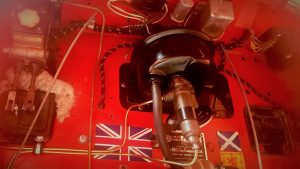
With some research and a chat to the MG repairer, the conclusion was that what many drivers are concerned about is often the “feel” of the brake peddle compared to a modern car. The MGA peddles being so close together, for me makes the whole action of operating the peddles slow and awkward which makes getting used to the “feel” of the old school braking system that little bit harder to adjust to. It was decided to start with installing the after market brake booster with the option to go with discs later if needed.

As it turned out, the booster works fantastically. The brake pedal has a feel and touch more akin to what we are used to in modern cars, I also found the brakes a lot more responsive, to me it seems to speed up the response time, important because of the awkward and close proximity of those peddles. The car readily dives in the front end now, it’s easier to apply the brakes firmly which translates into confidence driving in traffic. Gone are the visions of rear ending a fellow road user with the precious MGA.
The cost in my opinion was very reasonable for the transformation it makes to confidently driving the car in modern traffic. It was a very cheap performance upgrade well worth doing. The MG repairer did a fantastic job of making it a neat and ascetic installation on the plate on the rear shelf in the engine compartment, it can be taken out and returned to factory specs easily and there are no additional and unnecessary holes in the bodywork.

Gear box… The MGA is a 4 speed, the early 1500 model has no synchro in 1st. I’ve found these boxes are quite tight and notchy when in good condition and a bit loose and sloppy when not. There’s not a lot of travel in the lever. There’s no spring loaded return on neutral like modern cars which means going through the gears requires physically moving it through the H pattern gate, for example from 2nd -3rd. Failure to do so will result in the usual protest. Doubling the clutch with a quick 2nd stab makes changes smoother. A gentle and patient pace going the gears rewards the driver with a nice experience which I learned pretty quickly. I love this pic of the 63 years of wear on the gear lever on this car.
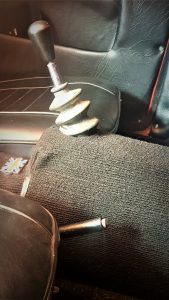 Hand brake… It is said a picture tells a thousand words. Not so in this pic of the hand brake. What it doesn’t show is the way it operates, and I love the way this operates. It was designed for a quick release in an era where running to your car at the start line when weekend racing was common practice. It works opposite to our modern cars. Pulling the lever up and then clicking the button locks in the hand brake, but here’s the cool part, a gentle lift on the lever releases it for a fast release action and the lever falls to the floor.
Hand brake… It is said a picture tells a thousand words. Not so in this pic of the hand brake. What it doesn’t show is the way it operates, and I love the way this operates. It was designed for a quick release in an era where running to your car at the start line when weekend racing was common practice. It works opposite to our modern cars. Pulling the lever up and then clicking the button locks in the hand brake, but here’s the cool part, a gentle lift on the lever releases it for a fast release action and the lever falls to the floor.
Now why this is cool is because of the tight and awkward pedal spacing. When stopping in the traffic engaging the hand brake is quick and easy, knock it into neutral, my feet don’t have to fiddle with the awkward pedals, then anticipating when the lights go green I can be in gear, a light lift of the lever releases the handbrake and makes the whole action quick and easy, and I’m moving with the traffic. I’d love to have this in the MGB.

Upkeep… Classic cars though do need care, time, money and periodic repairs as they arise. They generally don’t however clock up a lot of miles so the upkeep is reasonable provided it is done on a regular basis. and insurance cost for this reason is very reasonable, cheaper than my regular car. Rego on club plates is very reasonable too which require membership in a qualifying car club.
So that’s a wrap up on a brief review of owning an MGA.
Happy trails.
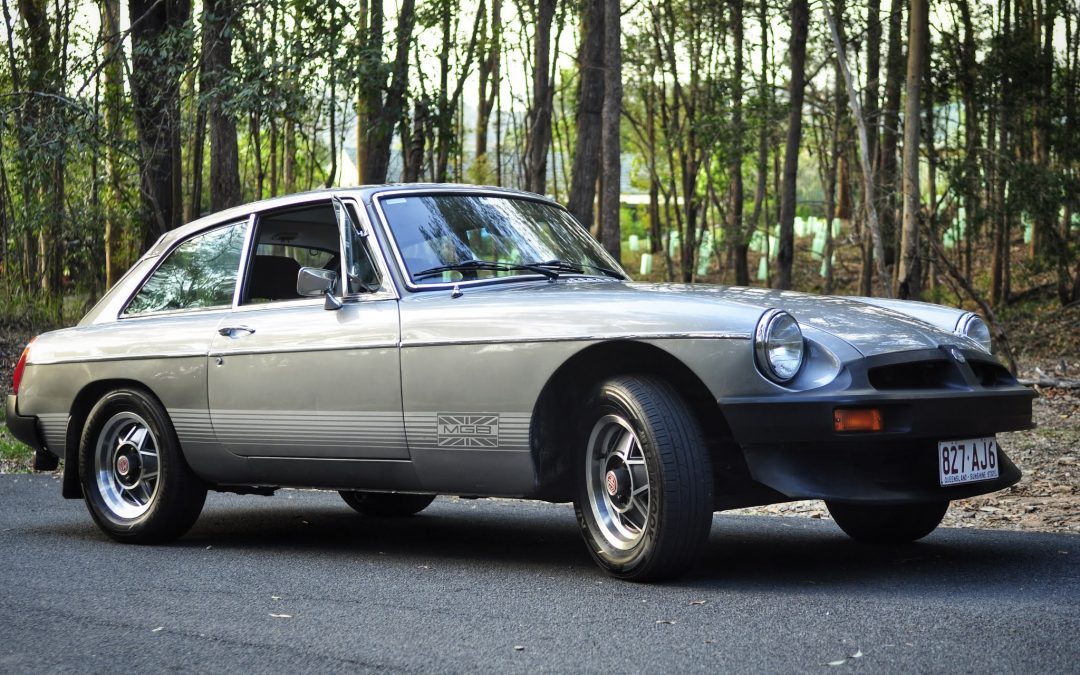
by David Maynard | Dec 7, 2020 | Review
Related Posts ==> Other MG Reviews
When I first started looking for an MGB, I had already decided I would be buying a GT model. In Queensland, where we have long, hot summers, it seemed to make more sense than a roadster. As luck would have it, and all the factors that come together when we make these choices, I settled on a 1980 MGB GT LE (Limited Edition), UK model.
It was a long-distance purchase that required transporting the LE from Melbourne via road freight. The transport worked out very well, and I discovered that people buy, sell and ship cars all over Australia. It’s common practice.
Cool Factor:
The MGB GT LE UK edition was a good purchase, if only for the “James Bond” factor that unexpectedly accompanied it. It seems the car has some resemblance to the silver Aston Martin DB5 that triggers memories of Sean Connery in Goldfinger. A comment I received recently was, “You must be James Bond!” So this LE model has lots of cool factors going on…thanks to Carrozzeria Pininfarina for the ‘fast back’ styling.
Cosmetic Condition:
Buying a classic car sight unseen from another state can be fraught with disappointment, but the LE came to me in excellent condition. I organised an independent pre-purchase inspection that resulted in an excellent report. However, there were a couple of items the pre-purchase inspection missed.
This MGB GT has received a respray at some point. Hence, the finish is in very nice condition… There is no rust. External trim, including the bumpers and factory fitted spoiler also found on the American “Limited Edition” models, is in excellent condition and very little pitting to the brightwork.
The cast alloy rims fitted to all of the GT LE cars produced, are the same rims fitted on the American “Limited Edition’ cars and believed to have been sourced from British Leyland’s store of rims for the Triumph Stag. They are in excellent condition, which according to receipts that came with the car were refurbished a few years ago – and they look it too.
The original GT LE silver and grey interior trim and cloth seats are in excellent condition. Likewise are the black carpets that may have been replaced. If they have been replaced, it would have been some time ago as there are some rub and ware patches in the usual spots but nothing that requires replacement. Most of the switches and knobs work as they should, including the funky centre console-mounted interior compartment lamp.
Driving:
Many years have passed since driving an old school car like the MGB, which, by the way, is a very different experience from driving a modern car. In the ’60s and ’70s, it was normal to drive a car with no air-conditioning, no power steering, distributor and points with a condenser that needed replacing or adjustment at 3-month intervals, carburettors that need tuning, in the case of the MGB twin SU’s that also needed to be balanced, wiring systems with inherent limitations, old suspension, no keyless entry, etc.
We’re talking “old school” driving here – you have to use the choke to start it and let it; you have actually to steer it through corners, you have to use some muscle to maneuver it in and out of car parking bays, you have to give the brake pedal that extra bit of pressure, use your gears to slow down, you have to use the quarter windows to get airflow to the interior, you have to use your key and walk around the car to unlock doors and hatches. You don’t expect explosive performance from a standing start with the factory 90 Hp (67 Kw in modern speak). But, it is still a great driving experience.
What these cars are made for is a gentle drive around town or over country roads. Being close to the road gives the feeling of speed without necessarily going fast and handles the bends with ease whilst feeling very secure. It has a button on top of the gear knob to electronically switch into overdrive without operating the clutch or changing gears. There is plenty of legroom too. I am relatively tall (185 cm or 6ft), and the seat is approximately 3/4 of the way back. Getting into the car is certainly not as easy as my big SUV, but it is not too difficult. It has a 15-inch steering wheel which does make contact with my thigh.
One of the surprising things I found driving this car is the lowish internal noise levels whilst driving. Even with the windows down, my wife and I can have a conversation quite easily whilst driving. I expected the internal noise level to be louder. I was also surprised at the effortless way it cruises down the freeway with the overdrive switched on. It is a cool and enjoyable driving experience.
Interior Space:
The interior space is surprising. The MGB GT looks very narrow, more so than I remembered from the ’70s, yet I am also surprised at how much internal space there actually is. It feels very comfortable with two adults in the car, and I don’t feel cramped or claustrophobic. In the case of the GT, the fastback styling provides quite a lot of space in the rear hatch area, which I think adds to the sense of spaciousness.
The legroom is excellent, and the foot pedals are spaced well enough to operate comfortably, even with my larger dress style work shoes. However, wearing a pair of large safety boots might present a challenge. Seat adjustment is adequate, both forward/back and tilting the backrest.
The original steering wheel is 15in, and there is no adjustment for the steering column.
The dashboard area is old school and cool – (right to left): Temperature gauge; Tachometer; Fuel gauge; Speedometer; Oil Pressure gauge; Hi-beam indicator light; Charge indicator light plus Dash light brightness control. In my normal driving position, my right-hand blocks the temperature gauge view, so to check that, I need to lean forward a little. The passenger side has a reasonable glove box in size for a small car and works well. Under the glove box are the bonnet release lever, a lever to open/close the air vent, and a small compartment in the footwell area that would easily hold a street directory plus more.
The middle console – (top to bottom) – Various switches for the fan, internal lamp, and hazard lights; Cigarette lighter, Internal Lamp, Choke Leaver; Radio; Fan Temperature Control, Clock (unique to the LE), and Air Fan Control Knob; console platform surrounding the gear leaver, ashtray and a console compartment that is small and narrow but somewhat functional. The hand brake lever is attached to the tunnel, but it does rub against my thigh whilst driving.
The rear seat is not functional for passengers to today’s standards and does not have seat belts. This area would be very suitable for storing handbags and similar-sized items. A medium-sized dog would fit there quite easily. My brother has researched fitting an air conditioner in his GT and was advised this area could house the internal condenser unit with some creativity. So this area is quite functional.
The rear hatch area is very nice. Not large but quite adequate to transport shopping, picnic supplies, or even a swag and associated
camping gear for an overnight camping trip, or luggage for an overnight glamping trip if that is more your style.
Seat Belts – being a 1980 model car, the LE had factory-fitted inertia-style seat belts with the fixed latch anchored at the base of the tunnel. In my case, both of those seat belt units have been replaced. One of those, the driver’s side, was replaced recently by me.
Related Posts ==> Seat Belt Replacement
Given the size of the car, I find the internal space surprisingly adequate for normal daily use.
Performance:
A standard MGB is by no means a performance car. A lot of the technology is old, even beyond the car’s age, with the B series engine having its origins in 1947 with a few different versions – 1200cc, 1500cc, and 1600cc used in the MGA’s, and the MGB’s 1800 cc engine. My wife’s car is a standard 2016 Toyota Corolla 1800 cc engine which is a zip machine – it just zips everywhere and quickly. No comparison with a stock standard MGB.
Some people carry out various engine performance upgrades. Fitting a supercharger is a popular option that does increase the performance quite a lot. My understanding of a supercharged MGB is the added torque makes low-speed driving in traffic and the suburbs very friendly with fewer gear changes, and highway driving is much more spirited and fun.
This LE came with the original twin SU carburettors, and aftermarket extractors were fitted on the car when I got it, with standard size exhaust and muffler.
Gear Box:
The MGB is a 4-speed manual. This LE has full synchromesh and overdrive gearbox. The overdrive switch located at the top of the gear knob was used on earlier Triumph cars for some years. The LE overdrive operates in 3rd and 4th, standard on all RHD cars from 1976. On North American cars from 1977, it operated only on top gear.
Operating the clutch in my LE is very smooth – a lot smoother than I can recall in any other manual cars I have driven. The gearbox is quite close and notchy and works very well. Given the reverse position, which is down and to the left, the first couple of times I drove the car when changing from 1st to 2nd, I maneuvered the gear stick too close to reverse, which responded with the usual protest. I very quickly made the appropriate adjustment and no longer having any trouble with that change.
The overdrive, a Laycock LH type, works very well and drops the revs by approximately 4000 rpm, making a big difference on the highway and even around back streets. It makes for a more comfortable ride.
Braking:
Brakes on the MGB GT LE are period standard – disk brakes at the front (no brake boosting system), drum brakes at the rear, and a hand brake lever that operates in the normal way with a button release. Before purchasing the LE, I read a review on old car braking systems. In many cases, the conclusion was that the issue many drivers are concerned about is often the “feel” of the brakes compared to a modern car. Once you get used to that feeling, the brakes are adequate for a standard MGB. Keeping that in mind, when I had some test drives, I very much agree with the concept of “feel” – you might need to give the pedal a bit more of a squeeze, and that’s where the feel comes in. However, the brakes work fine. I notice the difference more when I jump back into my modern SUV, where at first I tend to stab at the brakes.
I also recall from my driving experiences of the ’70s that I quickly got in the habit of using the gears to assist with slowing down – truth be told, as a 17/18-year-old in the 70’s my driving style was a bit more radical than it is now.
Upkeep:
Keep in mind that a 40 plus-year-old car is a classic car, and they do need care, time, money, and periodic repairs as they arise. Many old classic cars are club cars and don’t clock up a lot of miles, so the upkeep is reasonable provided it is done regularly. I was also a little surprised at the low cost of insurance on my LE, so make sure you have appropriate insurance.
Potential Upgrades:
Many upgrades can be carried out on old classic cars. We have a post that provides
more details on this topic, but here is a brief list of ideas:
Electronic Ignition
Brake booster upgrade
Disk brakes rear
Gearbox upgrade to 5 speed
Supercharger for that little extra performance
Air conditioning
Suspension upgrades
Bumper/valance upgrades
Extractors and sports exhaust
15in steering wheel
15in wheels and lower profile tyres
Wiring looms
Electric window
Central locking
Engine cooling system
And much more
That’s a Wrap:
So that’s a wrap-up on a brief review of owning an MGB GT LE. This particular car is in very nice original cosmetic and mechanical condition. It drives very well and, for a car from this era, it drives better than expected. It also gets attention when I’m out and about in it.
The one thing the GT LE has over all the other MGB’s – it has that unique James Bond factor, courtesy of the Pewter Metallic silver, resembling the Aston Martin DB5 in Goldfinger – “You must be James Bond!”
So there it is – shaken, not stirred.
Happy trails.

by David Maynard | Dec 6, 2020 | MGB GT LE, Review
Related Posts ==> Faulty Ignition Relay
Whilst thinking through purchasing options for an MGB, I decided I have limited time to allocate to any kind of restoration project. Accordingly, the criteria for my first MGB experience was either a car that had received a lot of restoration work or one that was original and in very good condition, requiring minimal work.
I had also established a preference for a GT. Living in South East Queensland, with a subtropical climate and long hot summers, a roadster would be too hot.
I had spotted at least one MGB GT that had received a lot of restoration work but I was a little slow in the uptake and that opportunity slipped away fairly quickly. Although I didn’t get the opportunity to look at or demo the vehicle, it was clearly a quality car that had received some high quality work. Speaking to the owner over the phone confirmed the extent of restoration work carried out. Given the very reasonable price, it is no wonder the car sold very quickly.
My next inspection was a roadster listed locally. Although I was looking for a GT, the intention of looking at this roadster was to get a better feel for what to look for. That turned out to be a smart exercise. Although the price was quite low, it was also a substandard example of an MGB and revealed the types of issues to look for. It was a regular drive for the seller, no effort was made to present the car well, it was clearly not well looked after and likely had mechanical issues to match, had obvious signs of rust in the normal places (sills, doors etc) and I couldn’t even test drive the vehicle as the seller didn’t have the key.
The next example I looked at was the car I eventually purchased. It was a reasonably priced MGB GT LE UK edition listed in Melbourne Vic. At the time Victoria was in the middle of a COVID-19 lockdown. Given severe restrictions on movement around town locals couldn’t carry out any inspections. I engaged a local mechanic to carry out a pre-purchase inspection. Based on that inspection I purchased this vehicle for the following reasons:
- price was very good
- the seller had carried out limited but key repairs including a new steering rack and new brake system components
- the seller maintained a file of work carried out, including all work carried out by the previous owner
- the car had for many years been a club car and been very well cared for and maintained
- condition of the car was clearly very good and confirmed by the pre-purchase inspection
- mechanically the car was in very good condition
- in the words of the pre-purchase inspection mechanic, the vehicle was “faultless”
My expectation on pickup from the depot was to jump in the car and drive it home. Sadly, this was not the case as some issues started to reveal themselves at the depot.
Firstly, the car would not start. I had a new battery fitted but still no start. The car eventually started and I left the deport with my wife travelling behind me. It travelled about 500 meters and stopped – just cut out as it had run out of fuel. As the seller mentioned it was low on fuel I assumed the tank was empty. I subsequently put some fuel in and it started again. Another 500 meters later it stopped again in a similar fashion.
At that point, my wife and I agreed she would drive back to the transport depot and request a tow truck to pick it up and deliver home. My wife and the yard manager returned with some more fuel as there were no tow trucks available at the time. Thinking it was low on fuel the yard manager commenced topping up the tank but it quickly overflowed. So the problem was obviously not fuel. It started again so we decided to give it another shot at driving approximately 15km home. Buoyed by the car driving 5 km further I thought it was going to make it home but sadly it stopped again. It seemed to stop as if it had run out of fuel and some odd electrical things were going on like blinkers not working, dash charge light coming on etc.
The car ended up getting home unceremoniously on a tilt tray truck. A mechanic friend and I were able to carry out some basic checks. Believing it may have been the alternator and or associated voltage regulator, we removed that and had it checked but nothing wrong with that.
I then took it to a local auto electrical workshop and the problem was eventually tracked down to a faulty and burnt out ignition relay. That relay also controls the blinkers and some dash gauges, hence the other odd electrical symptoms also resolved.
It was an interesting learning curve as this little $5 part caused a lot of grief and some unexpected costs (new battery, tow truck and auto electrician).
See this post for further details on symptoms and resolution of faulty ignition relay.
Faulty Ignition Relay
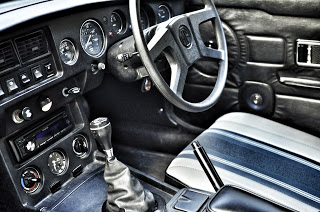
by David Maynard | Dec 6, 2020 | MGB GT LE, Review, Uncategorized
Related Posts ==> MGB GT LE 1980
The limited edition MGB’s were interesting cars. Although they didn’t poses any special technical or performance related features, each one offered very unique cosmetic features. There were a couple of different limited edition MGB’s made.
1. Jubilee, 1975MGB
2. Limited Edition LE (1979-1980) – US edition
3. Limited Edition LE (1980) – UK edition.
MGB Jubilee:
In May 1975 Abingdon produced 750 specially prepared MGB GTs to celebrate what British Leyland thought to be the MG Car Company’s fiftieth anniversary of the production of MG Cars. Features included some technical changes to meet new US safety standards plus cosmetic features including colour (green only), gold decals and V8 alloy wheels.
MGB LE – US Edition:
In 1979 British Leyland intended to produced 500 limited edition (LE) model roadsters for the US market but due to demand ended up producing 6682. The US LE model was similar to the UK LE model but with different fittings and colours – black only.
MGB LE – UK Edition:
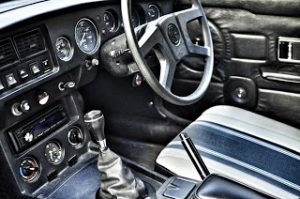
Unique interior of MGB GT LE – UK Edition
These cars were built at Abingdon in 1979/80 and were in fact the last MGs to be built at the famous factory before its closure in October 1980. A total of 1,000 Limited Edition MGBs were produced, 420 in Roadster form, 580 in GT form with the very last of each model going to the Heritage Trust Museum at Gaydon to add to their collection of historic vehicles.
Features included some technical changes and unique cosmetic features including colour (Pewter for GT model and bronze for roadster), stripe decals and Triumph Stag alloy wheels.
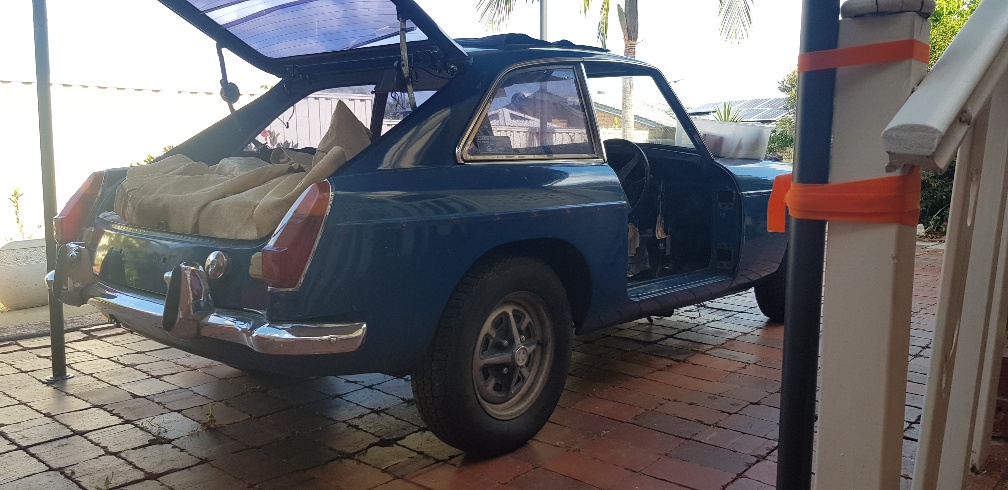
by Liz Maclean | Dec 6, 2020 | Review
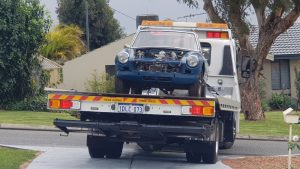
Back story
After purchasing my first MG, a 1971 MGB L Roadster, interest in all things MG progressively consumed more and more of my thoughts, energy and time. In our teenage years, my brother and I would visit car dealers and drive sports cars that appealed to us. However, at age 19 I bought a Datsun 2000S Fairlady and had it for 10 years. Most of that time it was my only car but In a moment many times regretted, I sold it. Buying the MGB Roadster was like coming home for me, picking up where the Datsun 2000S left off.

A similar growing interest in MG’s escalated with my brother buying a nice MGB GT LE UK edition. My son around this time shared his desire to learn how to work on cars. On YouTube, he subscribed and followed a restoration project on, of all things, an MGB GT. I knew his favourite car of all time is a 70’s Mach 1 Mustang and I learned specifically the fastback styling is what appeals to him. Furthermore, the MGB GT has the fastback styling he likes. That makes sense to me. Our conversation came around to my long-held soft spot for MGB GT’s with their pretty lines and ‘fastback’ styling. I recounted admiring a Teal Blue example in a car park many years ago and dreaming of owning one.
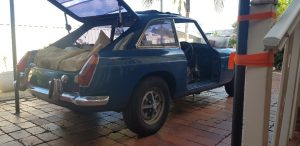
Providence
As providence would have it a Teal Blue MGB GT popped up for sale local to me. My son and I talked about getting it as a joint project car. In 2003 it had been taken off the road for some restoration work, the driveline had been rebuilt, motor, overdrive gearbox and diff. The alternator, twin Su’s, radiator and brake system with vacuum booster was rebuilt and accompanied with invoices for the work done. The interior was completely gutted and some exterior parts and engine parts in crates and boxes. The inevitable rags were stuffed into vulnerable engine orifices. Arrangements were made to view it. A deal was eventually struck and home came the Teal Blue GT unceremoniously on the back of a flatbed truck. The work that is done so far started 17 years ago, now it’s time to restore that classic raspy MGB exhaust note.
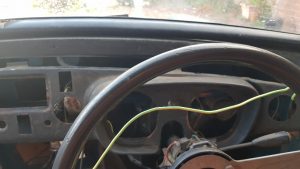
Where to start
Initially, I was overwhelmed. Where do I start with the boxes of parts, nuts, bolts and bits and pieces? The car was generally in a sorry state. For the sake of doing something, it seemed logical to start by cleaning it inside and out. The last date on the pile of receipts accompanying the purchase is 2007 and I assume the only thing that’s changed since then is the accumulation of dirt and dust.
The last few months I’ve spent sifting through the bits and pieces, researching online, and getting an idea of which direction the project should go. Firstly, one option is to take it down the path of restoration. I baulk at the amount of money involved to do that, as well as the amount of time it would take. Frankly, I want to see it up and running and driving down the road under its own steam, as does my son.
Secondly is an option I’d never heard of before and entirely not considered. I stumbled across Rat Rods which gave me the idea to simply refurbish the car. Essentially retain as close to the original car and patina as practically and aesthetically possible. For instance, Rat rods are a good example of this idea and it appeals to me to approach a classic MGB GT build in this way, especially one in Teal Blue.
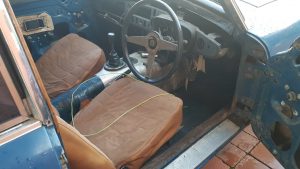
Goals
The goal is to build a reliable classic car to cope with the demands of an everyday driver that will take me to retirement and beyond. Moreover, I’d like to hook up to a homemade micro camper trailer to attend National club runs. Originally, the idea of a restoration project appealed to me. Now it’s clear I want to go with option two to refurbish the GT while preserving the original car and patina.
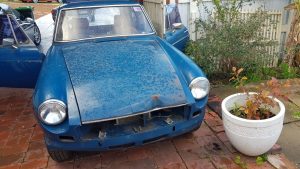
Talking it through with my son who calls the Teal Blue GT his inheritance totally agrees. For him, it was the only way he ever viewed it. Great news, the direction of the project is established, forward we go.
Watch this space…..
























 Hand brake… It is said a picture tells a thousand words. Not so in this pic of the hand brake. What it doesn’t show is the way it operates, and I love the way this operates. It was designed for a quick release in an era where running to your car at the start line when weekend racing was common practice. It works opposite to our modern cars. Pulling the lever up and then clicking the button locks in the hand brake, but here’s the cool part, a gentle lift on the lever releases it for a fast release action and the lever falls to the floor.
Hand brake… It is said a picture tells a thousand words. Not so in this pic of the hand brake. What it doesn’t show is the way it operates, and I love the way this operates. It was designed for a quick release in an era where running to your car at the start line when weekend racing was common practice. It works opposite to our modern cars. Pulling the lever up and then clicking the button locks in the hand brake, but here’s the cool part, a gentle lift on the lever releases it for a fast release action and the lever falls to the floor.










Recent Comments